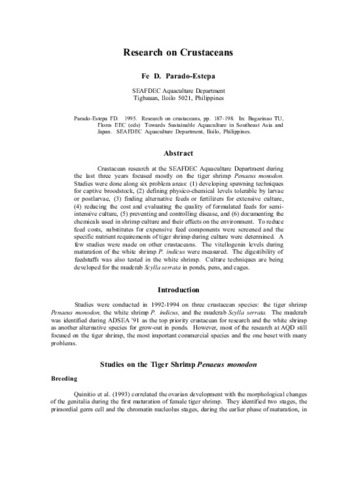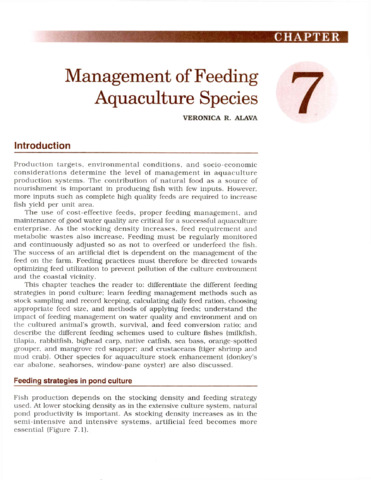Research on crustaceans
- Global styles
- MLA
- Vancouver
- Elsevier - Harvard
- APA
- Help

Date
1995Author
Page views
10,055ASFA keyword
tolerance 
disease control
chemical compounds
feed composition
disinfectants
fertilizers
breeding
nutritional requirements
environmental factors
research
breeding stock
drugs
crustacean larvae
feeds
shrimp culture
crustacean culture
pond culture
spawning
crab culture
aquaculture economics
hatcheries
digestibility
pesticides
cage culture
disease prophylaxis
feeding experiments

disease control

chemical compounds

feed composition

disinfectants

fertilizers

breeding

nutritional requirements

environmental factors

research

breeding stock

drugs

crustacean larvae

feeds

shrimp culture

crustacean culture

pond culture

spawning

crab culture

aquaculture economics

hatcheries

digestibility

pesticides

cage culture

disease prophylaxis

feeding experiments

AGROVOC keyword
Taxonomic term
Metadata
Show full item record
Share
Abstract
Crustacean research at the SEAFDEC Aquaculture Department during the last three years focused mostly on the tiger shrimp Penaeus monodon. Studies were done along six problem areas: (1) developing spawning techniques for captive broodstock, (2) defining physico-chemical levels tolerable by larvae or postlarvae, (3) finding alternative feeds or fertilizers for extensive culture, (4) reducing the cost and evaluating the quality of formulated feeds for semiintensive culture, (5) preventing and controlling disease, and (6) documenting the chemicals used in shrimp culture and their effects on the environment. To reduce feed costs, substitutes for expensive feed components were screened and the specific nutrient requirements of tiger shrimp during culture were determined. A few studies were made on other crustaceans. The vitellogenin levels during maturation of the white shrimp P. indicus were measured. The digestibility of feedstuffs was also tested in the white shrimp. Culture techniques are being developed for the mudcrab Scylla serrata in ponds, pens, and cages.
Suggested Citation
Parado-Estepa, F. D. (1995). Research on crustaceans. In T. U. Bagarinao & E. E. C. Flores (Eds.), Towards Sustainable Aquaculture in Southeast Asia and Japan: Proceedings of the Seminar-Workshop on Aquaculture Development in Southeast Asia, Iloilo City, Philippines, 26-28 July, 1994 (pp. 187-198). Tigbauan, Iloilo, Philippines: Aquaculture Department, Southeast Asian Fisheries Development Center.
Type
Conference paperISBN
971851127XCollections
- ADSEA '94 [21]
Related items
Showing items related by title, author, creator and subject.
-
Management of feeding aquaculture species
Alava, Veronica R. (Aquaculture Department, Southeast Asian Fisheries Development Center, 2002)This chapter teaches the reader to: differentiate the different feeding strategies in pond culture; learn feeding management methods such as stock sampling and record keeping, calculating daily feed ration, choosing ... -
Updates on the larviculture of mud crab at SEAFDEC/AQD
Quinitio, Emilia T. ; Huervana, Joana Joy D. C.; Virgula, Juliette C.; Parado-Estepa, Fe D. (Aquaculture Department, Southeast Asian Fisheries Development Center, 2017)
Although the mud crab (Scylla serrata) hatchery technology has been developed, issues such as high cost of production due to the need for additional facilities and labor for natural food culture, inconsistent survival rate ...
; Huervana, Joana Joy D. C.; Virgula, Juliette C.; Parado-Estepa, Fe D. (Aquaculture Department, Southeast Asian Fisheries Development Center, 2017)
Although the mud crab (Scylla serrata) hatchery technology has been developed, issues such as high cost of production due to the need for additional facilities and labor for natural food culture, inconsistent survival rate ... -
Evaluation of various protein sources for Penaeus monodon postlarvae
Lim, Chhorn; Suraniranat, Prawit; Platon, Rolando R. (University of the Philippines, Los Baños, 1979)Penaeus monodon postlarvae with an average weight of 15.61 mg each were fed fresh brown mussel meat and artificial diets containing casein, shrimp meal, squid meal and Spirulina as protein sources at a daily rate of 20 per ...




